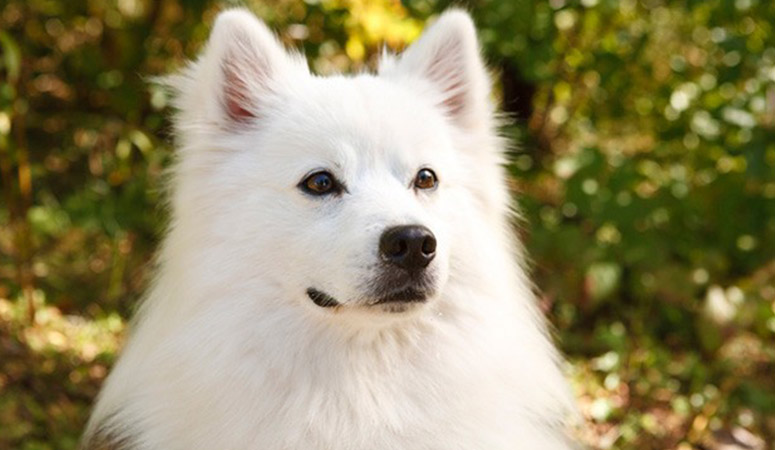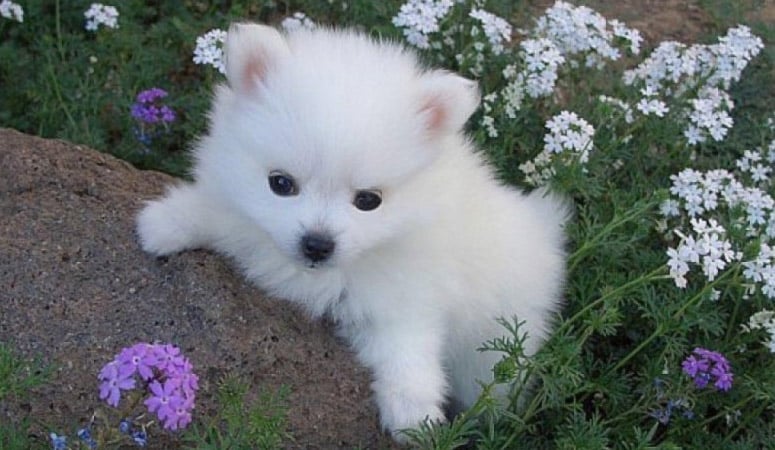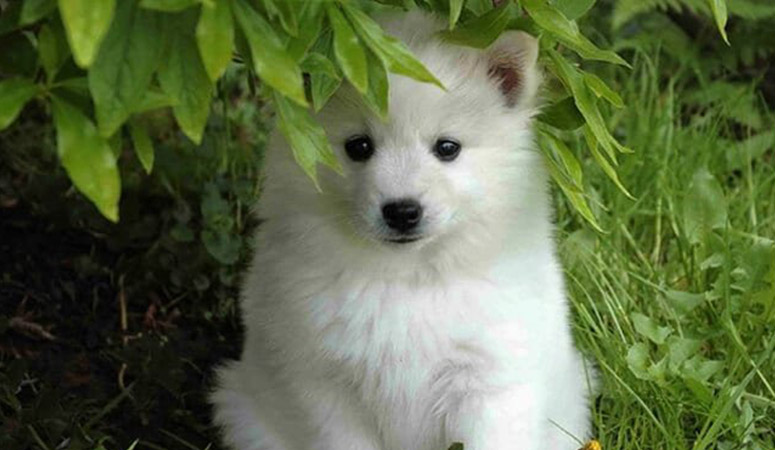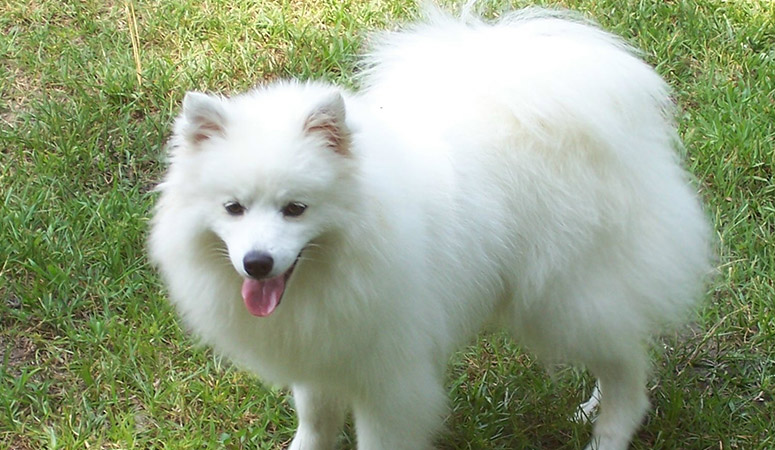American Eskimo Dog
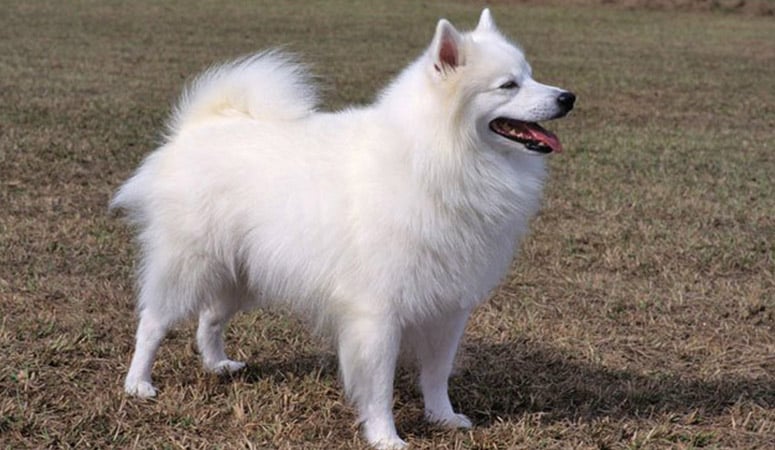
The American Eskimo is a striking dog who has a white coat, sweet expression, and black eyes, and he is called “the dog beautiful” by admirers. They are intelligent and playful dogs who would be thrilled at any chance to entertain. Neither shy nor aggressive, always alert and friendly, they are generally obedient companions.
| Other Names | American Deutscher Spitz, American Eskimo Spitz, American Spitz |
| Color | White, White & Biscuit |
| Height | Males: 15-19 inches. Females: 14-18 inches. |
| Weight | Males: 18-35 pounds. Females: 18-35 pounds. |
| Life Span | 13-15 years |
| Personality | Playful, Perky, Smart |
| Exercise | Energetic |
| Origin |
| Popularity | #120 |
| Groom Needs | Weekly |
| Kids Friendly | Yes |
| Dog Friendly | Yes with supervision |
| Watch Dog | |
| Family Dog | Yes |
| Litter Size | 5-7 |
American Eskimo Dog Pictures
American Eskimo Dog Video
Introduction
Commonly called the Eskie, the American Eskimo Dog is a highly social animal, fraught when neglected, and highly intelligent. They move with a courageous and brisk stride and are lovable companions and family friends. The double coat, usually white in color, comprises a short and dense undercoat covered by a longer coat of hair that forms the topcoat. The chest and neck regions are covered by thicker fur.
There are three size varieties of the Eskie — toy, miniature and standard sizes. Toy sizes are diminutive, standing around 9-12 inches tall and weighing a mere 6-10 pounds. Standing 12-15 inches at the shoulder and weighing about 12-20 pounds, miniature-sized Eskies appear larger than the toy size variety. However, standard-sized members are elegant, measuring somewhere around 15-19 inches from shoulder to paw and likely to tip the weighing scales within the range of 25-35 pounds. The American Eskimo Dog has an average life expectancy of 12-15 years.
Living with American Eskimo Dog
The American Eskimo Dog has a fluffy, white double coat – a short, dense undercoat and a longer outer coat, but it is not difficult to keep clean. This dog breed sheds a lot, frequent brushing is required to cut down on the amount of fur left around the house, and to prevent matting (especially behind the ears). A thorough brushing two or three times a week is helpful to remove dead hair and prevent matting.
The owner needs to know that Eskies should only be bathed once every couple of months, depending on how dirty they get, because being bathed too often may cause skin problems. Also, check and clean the ears for dirt, redness, or a bad odor that may indicate an infection. And brush the teeth several times a week to keep fresh breath and prevent gum disease. Last, trim the nails regularly, usually once a month.
American Eskimo Dogs are indeed large dogs in small packages, they need a lot of exercise and mental challenges. If not given enough exercise and left alone in a backyard, they would quickly become destructive. Exercise could be in the form of a good walk or run every day, some indoor play and brain games. Although many of the physical exercise needs of the toy variety can be met with indoor games, it still needs the mental stimulation of walking and sniffing outdoors. Also, taking your Eskie to a dog park is a good choice for exercise.
Generally, it is recommended to fees the American Eskimo Dog with a half to two cups of high-quality dry dog food every day, divided into two meals. And there should be clean and fresh water at all times. More importantly, the food amount should depend on the dog’s weight, size, age, and activity level.
Some dogs are easy to get overweight, so you need to watch their calorie consumption and weight level all the time. Treats may be an important aid in training, but excessive intake can lead to obesity. Also, owners need to distinguish which human food is safe for dogs and which are not. If you have any problems with your dog’s weight or diet, just consult from your veterinarian.
American Eskimo Dogs are prone to the following health conditions: Hip dysplasia, progressive retinal atrophy, Obesity, Luxating patella, Pyruvate kinase deficiency (PKD), etc.
Major concerns: none
Minor concerns: PRA, CHD, patellar luxation
Occasionally seen: diabetes
Suggested tests:
Hip Evaluation
PRA Optigen DNA Test
Ophthalmologist Evaluation
Total Annual Cost: $2674
Cost is estimated for the first year and may vary depending on many factors, such as dog food, health care, leash, collar, licensing, possible fencing, crates, training and obedience classes, dog-walking, grooming, treats, toys, flea, tick, and heart-worm meds, microchips, etc.
American Eskimo Dogs are intelligent and eager to please dogs that can learn basic obedience with ease. And they respond well to treats, fun activities are more useful than boring repetition when training. It is recommended to start early socialization and puppy training classes, the same as other dog breeds.
Eskies prefer companioning and interacting with their owners and they tend to develop problem behaviors if left alone too often for long periods of time. Also, as former circus dogs, they are natural at advanced tricks and obedience training. They excel at agility disc dog competitions, rally, and other high-energy competitions.
History
Contrary to their name, the American Eskimo is no more associated with Eskimos than it originated in America. They are Spitz-type dogs with a German origin. However, the name was changed to what it is known as today after World War I when a distaste for Teutonic affairs burned strongly in America. The German Spitz are believed to be ancestors of the breed, although, along the line, Japanese Spitz was said to have been bred into the gene pool. It is believed that German immigrants had their German Spitz dogs imported when they came to reside in regions of America, especially Wisconsin, Ohio, and Minnesota in the 1800s. They started out as farm dogs, moved on to become reputable watchdogs and more recently, companion dogs.
Its American history began to take a relish after World War I as many American breeders, in the spirit of patriotism, took a preference to call their dogs “American Spitz”. The beautiful appearance of the American Eskimo Dog, which it was later called (as adopted from a breed club name in Ohio), suggests that it was cut out for something else beyond the tatters of the farm. This became clear around the 1930s and 1940s when the American Eskimo became a fast favorite in the circus business and the dog show. Famous amongst these include the Barnum and Bailey Circus which even sold puppies at the end of shows.
The American Eskimo was first recognized as such in 1919 by the United Kennel Club. They were accepted as single dogs since there was no breed club for them at the time. The National American Eskimo Dog Association (NAEDA) was founded in 1970, after which they were registered as a breed. A breed club was formed in 1985 and was first registered by the AKC in 1995.
Helpful Information
Breed Club: AMERICAN ESKIMO DOG CLUB OF AMERICA
Breed Club Link: http://www.aedca.org/
Breed Club Rescue:
Breed Club Rescue Link: https://aedca.org/aedca_rescue.php

